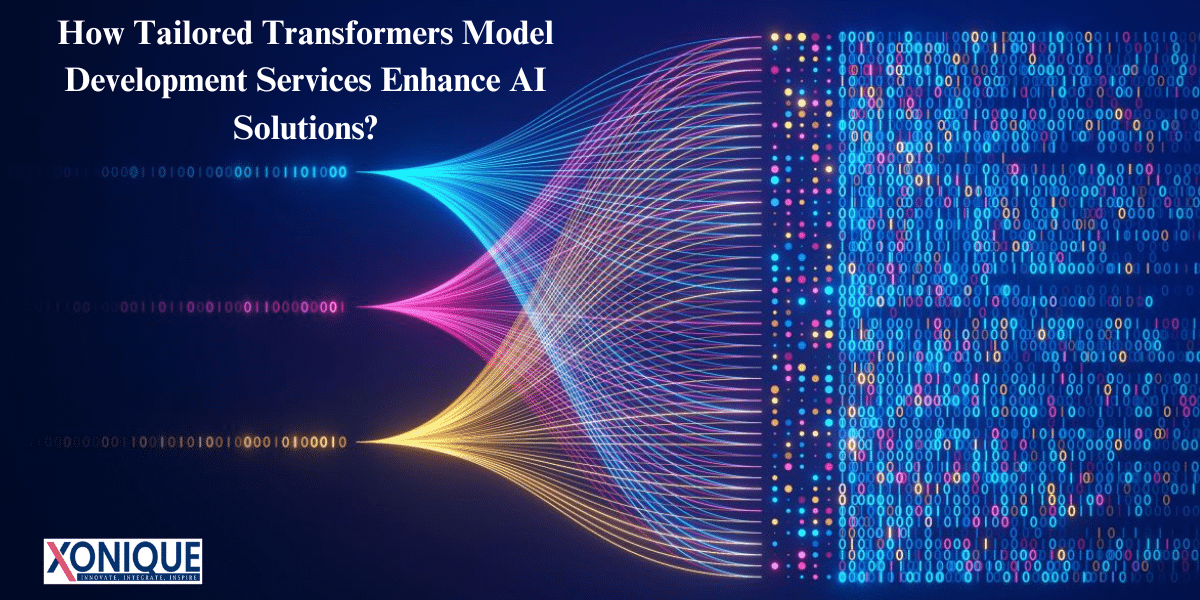Artificial Intelligence (AI) is a field that has experienced massive growth over the last few times, with models of transformers being identified as the primary catalysts of evolution. The models, based on sophisticated neural networks, are transforming the world in Natural Language Processing (NLP) and fundamentally changing how people interact with technologies that use language.
This article examines Model Validation Techniques, how transformers model development services enhance AI solutions and their impact on various areas.
Transformers In The AI Domain
The transformer architecture introduced new features like self-awareness, multi-head focus, and fully connected, position-specific feedforward networks. Self-attention enables the model to give distinct components of the sequence different amounts of significance when making predictions. Multi-head focus allows the simultaneous examination of several attention subspaces, and position-wise, fully connected feedforward networks effortlessly blend attention representations and inputs.
The features put the transformer model ahead of the previous models, achieving top marks in various NLP tasks, including computer-aided translation (CAT), language modeling, and text generation. Transformers introduced a brand-national training algorithm called the training algorithm for transformers, which is faster and more efficient than traditional RNN-based methods.
What Are The Effects Of Transformers In Artificial Intelligence?
Transformers are an example of a neural network structure that transforms or alters one input sequence into the output sequence. They acquire contextual information and observe relationships between the sequence’s components. Take this, for example, “What is the color of the sky?” The transformer model employs internal mathematical representations determining the relevance and connection between sky, color, and blue. The model uses this information to create the output “The sky is blue.” Organizations use the transformer model for sequence transformations, speech recognition, the match translation process, and protein sequence analysis.
Introduction To Transformers In AI
Transformers pioneered deep learning, revolutionizing natural language processing (NLP), and many other tasks powered by artificial intelligence (AI). From translating languages to composing lengthy documents, their expertise is unmatched.
Self-Attention Mechanisms
The newness transformers’ distinctive feature from other models is their unique use of self-attention systems. The innovative method allows them to effectively learn and analyze the complicated connections and interdependencies among all components of the input sequence.
BERT
A Major Step in the Field of Language Processing, The advent of BERT (Bidirectional Encoder Representations from Transformers) is a game changer. By understanding the bidirectional structure of language, BERT is significantly pushing the limits of what machines can comprehend and producing a more complex understanding of the language.
Beyond NLP
The plethora of transformers isn’t restricted to NLP. They’ve shown remarkable speech recognition, computer vision, and reinforcement learning abilities. They are paving the way to an era where their use can be endless, and their effect is unimaginable.
Advantages Of Transformer Model Development Services
The services for developing transformer models are essential to maximizing their potential. They provide businesses with the knowledge and resources needed to make the most of this innovative technology’s power. To ensure that companies can utilize these models to their full capabilities, they are designed for experts who specialize in the creation of transformer models and can tackle the challenges of data preprocessing, designing, architecture, learning, and fine-tuning.
The ability of these services to enhance customer experiences is just one of the main benefits. Businesses can develop individual and tailored relations with their customers by using transformer models. Transformer models allow companies to offer highly enjoyable and custom experiences that ultimately increase customers’ trust and satisfaction. Chatbots, for instance, can comprehend users’ natural language and respond accordingly to requests and recommendation systems that give precise and pertinent recommendations.
Model development services are an opportunity to improve operational efficiency. They can assist organizations in reducing time and costs through automation and simplifying procedures. Transformers help companies run more effectively and efficiently by automating the management of supply chains and answering customer questions.
The potential for innovation and disruption is a crucial element. These types of models make changes in the industry and the creation of new possibilities feasible. Businesses can benefit from the potential of these models by collaborating on model development, analyzing new use cases, extracting valuable information from enormous amounts of data, and constructing innovative solutions that expand beyond what’s feasible.
Furthermore, transformer model generation helps companies stay two steps ahead of their competitors. Utilizing the power of AI technology can make a massive difference in the current fast-paced technological world. Companies can gain an edge in competition, attract customers, keep them in the loop, and stay at the forefront of technological advancement by adopting AI-based methods and investing in their development.
Not least, modeling services help promote AI study and research. Businesses can contribute actively to the development of models by working with specialists in the subject matter, creating innovations, and expanding the capabilities of this fantastic technology.
Flavors Of Transformer Model
Numerous improvements and variants on the basic Transformer design have been created to tackle specific issues or increase performance on different jobs. The most notable improvements are:
BERT (Bidirectional Encoder Representations of Transformers)
The BERT model was developed by Google in 2000. BERT pre-trains Transformer-based models using large volumes of text in a bidirectional fashion. The model is able to understand the context better by focusing on both the preceding and next words. This can lead to substantial improvements in a variety of processes that require natural language, such as answering questions, sentiment analysis, and recognized entity names.
GPT (Generative Pre-trained Transformer)
The model was developed in collaboration with OpenAI. GPT is another variant of the Transformer model, which focuses on using autoregressive language models. GPT models, especially GPT-3, are based on massive amounts of text that can produce coherent and relevant text when presented with an instruction. GPT models have shown remarkable abilities across a range of language-related tasks, including text completion summary and dialogue generation.
XLNet
XLNet is a concept proposed by Google AI researchers that combines autoregressive and BERT models, such as GPT, to avoid the issues of capturing bidirectional context and preserve the advantages of models that use autoregressive algorithms. By utilizing permutations of input sequences throughout learning, XLNet achieves state-of-the-art results for a range of natural language comprehension tasks.
BERT-Based Models for Specific Domains
A variety of specialized variations of BERT are being developed to suit particular languages or domains. For instance, BioBERT is used to read biomedical information, SciBERT is used for scientific text, and Roberta for general-purpose language understanding. The models are refined on specific datasets for each domain to enhance performance for particular tasks in those areas.
Transformers That Come With Sparse Attention Mechanisms
To increase Transformer models’ scale efficacy and efficiency, scientists have investigated sparse attention strategies, which focus on paying attention to a small portion of tokens within the sequence instead of the entire sequence. This reduces computational complexity but maintains speed, making Transformers ideal for processing long sequences and larger data sets.
The advancements and modifications in the Transformer structure show the constant effort to expand the limits of understanding natural language and other aspects of artificial intelligence. The result is ever-more powerful and flexible models.
Impact Of Transformers On The AI Landscape
Since their invention, transformers have imprinted on the world of NLP by fundamentally changing how we interact using language-related technologies. The areas in which Machine Learning Development Company with the help of transformers have brought transformational change are:
Improving Machine Translation
Transformers significantly improve machine translation and tackle an issue that has been challenging for NLP. Google’s neural machine translation algorithm utilizes the transformer model and has achieved top efficiency. Similar to that, Facebook’s AI research team has created an algorithm for translation based on transformers. It has surpassed earlier models.
Enabling Advanced Chatbots And Virtual Assistants
Transformers are paving the way to sophisticated chatbots and virtual assistants by increasing the efficiency and accuracy of NLP tasks. The OpenAI GPT-3 model, which is rooted in transformers, is crucial in developing chatbots and virtual assistants that can generate human-like responses when asked questions based on text.
Enhancing Text Classification
Transformers have transformed the process of determining text, which has proved invaluable for sentiment analysis, spam detection, and content moderation. Google’s BERT model, which is part of the transformer’s architecture, has proven to be extremely accurate when it comes to nuanced text classification tasks.
Revolutionizing Search Engines
Transformers are changing the way search engines work by significantly increasing the precision of search queries using natural language. Due to the growing popularity of voice assistants such as Amazon’s Alexa and Apple’s Siri, natural language queries have become more frequent.
Key Components Of Transformers
The structure of the transformer is based on two fundamental elements: self-awareness and positioning encoding. Self-attention lets the model concentrate on various parts in the input sequence to decide how much focus to place on each component while processing a specific phrase. This technique allows the model to recognize the meaning and relationship of information.
Encoding for position is another crucial component, which gives the model an idea of the arrangement of the words or other elements within the sequence. In contrast to RNNs, which don’t perform data processing in a linear fashion, this kind of encoding is vital to keeping the order of events. The structure also breaks down into decoder and encoder blocks, each performing specific tasks in processing inputs and producing output.
Advantages Of Transformer Architecture
Transformers provide several advantages over the previous model of sequence processing. The ability of transformers to process complete sequences at the same time dramatically speeds up the process of the process of training as well as inference. Parallelization, in conjunction with self-attention, allows transformers to manage dependencies over a more extended period and more efficiently capture connections in data that cross vast gaps within the sequence.
In addition, they are highly efficient with computing and data resources. This is why they’ve been a significant factor in creating prominent model languages. Their efficacy and efficiency in different tasks have made them a trendy option within the machine learning industry, specifically for difficult NLP jobs.
Transformers In Machine Learning Large Language Models
Transformers constitute the core of numerous large language models, including GPT (Generative Pretrained Transformer) and BERT (Bidirectional Encoder Representations from Transformers). GPT, For instance, excels at creating human-like texts by absorbing vast amounts of data to create an equivocal and context-sensitive language. On the contrary, BERT is focused on understanding the meaning behind words and phrases in sentences. It is revolutionizing the tasks of the ability to answer questions or analyze sentiment.
The Machine Learning Model Validation is a significant step forward in the field of language processing, showing the ability of the machine to recognize and produce language at a similar level to the human level. Their successes have triggered the development of new technologies, which has led to the creation of new, more effective models.
Applications And Impact
Models based on transformers in the natural processing of language are numerous and expanding. They are utilized in language service translation, content generation tools, and developing AI agents that can comprehend and react to human voices. The impact of transformers goes beyond translation tasks. Transformers are currently being developed for areas such as bioinformatics and video processing.
These algorithms have a significant influence and offer improvements in accuracy, efficiency, and the capability to manage complex language tasks. As these models continue to develop, they are predicted to provide many new opportunities, including automated content creation, customized instruction, and even advanced conversational AI.
What Are The Possible Uses That Transformers Can Help In Enhancing AI Solutions?
It is possible to train massive transformer models for any kind of information, such as human language, music writing, programming languages, and much more. Here are a few examples of scenarios.
Natural Processing Of Language
Transformers let machines understand the meaning, interpretation, and generation of human language more precisely than before. They can summarize documents into coherent, pertinent text to suit a variety of situations. Virtual assistants, such as Alexa, use transform technology to understand and respond to commands from voice.
Machine Translation
Transformers are used in translation applications for real-time and accurate translations across different languages. They greatly improve the accuracy and speed of translations compared with prior technology.
Analysis Of DNA sequences
Treating DNA fragments as sequences similar to a conversation, Transformers can anticipate the consequences of genetic changes, recognize the genetic pattern, and determine the DNA areas that cause some diseases. This is essential in the field of personalized medicine, as studying the individual’s genetic profile could lead to more efficient treatment options.
Protein Structure Analysis
Transformer models can manage data sequentially and are therefore equipped to model the lengthy chain of amino acids that transforms into complicated proteins. Understanding protein structures is crucial in the search for drugs and biological processes. Computer programs can utilize transformers to determine the three-dimensional structures of proteins using only their amino acid sequences as input.
Transformative Power Of Transformer Models
The most recent AI innovation is Transformer models, a neural network structure that has proven highly effective in natural language processing. Researchers from Google first introduced them under the name BERT (Bidirectional Encoder Representations from Transformers). The models have now evolved into advanced versions like GPT-3 (Generative pre-trained Transformer 3), created by OpenAI.
Transformer models have a knack for understanding contextual context. This makes them extremely useful for applications such as language translation or text summarization. They also work well in answer-to-question systems. The company’s continuous improvement of Transformer structures reveals its determination to push the limits of understanding natural languages.
AI In Drug Discovery
Healthcare is experiencing an enlightening impact of AI, specifically for drug discovery. AI algorithms are currently sorting through massive databases to discover promising drug candidates, forecast their effectiveness, and speed up drug development. The use of AI will not only speed up research but also have the potential to provide new and more efficient therapies to patients quicker than ever before.
AI For Explainability
Indeed, the “black box” nature of specific AI models has long been a significant issue. Recent advances are focused on improving the explanation ability of AI models. Researchers are developing methods to enhance the explainability of AI algorithms to make them more transparent and more understandable. This will provide insight into the decision-making process of complicated models. Understanding AI is essential for building confidence, particularly in delicate sectors like healthcare and finance.
AI-Driven Personalization
AI changes the way people experience digital content with personal suggestions. Advanced machine learning algorithms analyze users’ preferences, behavior, and past data to customize the content recommendations offered on streaming services, websites for e-commerce, and even social media. This degree of individualization is not only a way to improve the user’s experience but also enhances the efficiency overall of online platforms.
AI In Edge Computing
Edge computing, where data processing is close to the place of data creation, has been gaining momentum, and AI is a critical element of this transformation. AI models are now being implemented directly on devices at the edge, removing the need for massive data transfers to central servers. This improves instantaneous processing and addresses security concerns by storing private information in the device.
The field of AI is constantly changing, and new advances are continually changing the landscape of AI. From the most advanced model of language to groundbreaking applications in the field of drug discovery and improvements in the interpretability of models, AI is poised to change how we live and work. With these advancements in the making, it is crucial to be aware of the most recent advances in AI and the potential of AI to build an intelligent, productive, and interconnected society. The future of AI offers exciting opportunities, and the only constant thing is the pursuit of advances in artificial intelligence.
Conclusion
Shortly, the potential of Machine Learning Development Services and ML transformers is positive and full of promise. Researchers continue to develop new ideas to improve the effectiveness and capabilities of the models. It is possible to expect transformers to be used in various areas, further expanding artificial intelligence technology.











